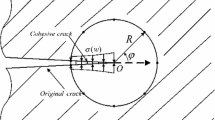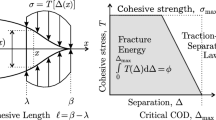Abstract
In this paper, an adaptive finite element procedure is presented in modeling of mixed-mode cohesive crack propagation via the modified superconvergent path recovery technique. The adaptive mesh refinement is performed based on the Zienkiewicz–Zhu error estimator. The weighted-SPR recovery technique is employed to improve the accuracy of error estimation. The Espinosa–Zavattieri bilinear cohesive zone model is applied to implement the traction-separation law. It is worth mentioning that no previous information is necessary for the path of crack growth and no region of the domain is necessary to be filled by the cohesive elements. The maximum principal stress criterion is employed for predicting the direction of extension of the cohesive crack in order to implement the cohesive elements. Several numerical examples are analyzed numerically to demonstrate the capability and efficiency of proposed computational algorithm.
Similar content being viewed by others
References
Babuska I, Rheinboldt WC (1978) A posteriori error estimates for the finite element method. Int J Numer Methods Eng 12: 1597–1615
Barenblatt GI (1959) The formation of equilibrium cracks during brittle fracture: general ideas and hypotheses. J Appl Math Mech 23: 622–636
Barenblatt GI (1962) The mathematical theory of equilibrium cracks in brittle fracture. Adv Appl Mech 7: 55–129
Bouchard PO, Bay F, Chastel Y (2003) Numerical modelling of crack propagation: automatic remeshing and comparison of different criteria. Comp Methods Appl Mech Eng 192: 3887–3908
Camacho GT, Ortiz M (1996) Computational modeling of impact damage in brittle materials. Int J Solids Struct 33: 2899–2938
Carpinteri A, Cornetti P, Barpi F, Valente S (2003) Cohesive crack model description of ductile to brittle size-scale transition: dimensional analysis versus renormalization group theory. Eng Fract Mech 70: 1809–1839
Cervenka J (1994) Discrete crack modelling in concrete structures. PhD thesis, University of Colorado
Chandra N, Li H, Shet C, Ghonem H (2002) Some issues in the application of cohesive zone models for metal–ceramic interfaces. Int J Solids Struct 39: 2827–2855
Cornec A, Scheider I, Schwalbe KH (2003) On the practical application of the cohesive model. Eng Fract Mech 70: 1963–1987
Dugdale DS (1960) Yielding of steel sheets containing slits. J Mech Phys Solids 8: 100–114
Elices M, Guinea GV, Gomez J, Planas J (2002) The cohesive zone model: advantages, limitations and challenges. Eng Fract Mech 69: 137–163
Erdogan F, Sih GC (1963) On the extension of plates under plane loading and transverse shear. J Basic Eng 4: 519–527
Espinosa HD, Zavattieri PD (2003) A grain level model for the study of failure initiation and evolution in polycrystalline brittle materials. Part I: Theory and numerical implementation. Mech Mater 35: 333–364
Freed Y, Banks-Sills L (2008) A new cohesive zone model for mixed mode interface fracture in biomaterials. Eng Fract Mech 75: 4583–4593
Geubelle PH, Baylor J (1998) Impact-induced delamination of laminated composites: a 2D simulation. Compos Part B Eng 29: 589–602
Goyal-Singhal V, Johnson ER, Davila CG (2004) Irreversible constitutive law for modeling the delamination process using interfacial surface discontinuities. Compos Struct 64: 91–105
Griffith AA (1920) The phenomena of rupture and flow in solid. Philos Trans R Soc Lond B Biol Sci 221: 163–197
Hillerborg A, Modéer M, Petersson P (1976) Analysis of crack formation and crack growth in concrete by means of fracture mechanics and finite elements. Cem Concr Res 6: 773–782
Hussain MA, Pu SL, Underwood JH (1974) Strain energy release rate for a crack under combined mode I and mode II. Fracture Analysis, ASTM STP 560, Philadelphia, pp 2–28
Khoei AR (2005) Computational plasticity in powder forming processes. Elsevier, UK
Khoei AR, Azadi H, Moslemi H (2008) Modeling of crack propagation via an automatic adaptive mesh refinement based on modified superconvergent patch recovery technique. Eng Fract Mech 75: 2921–2945
Khoei AR, Gharehbaghi SA, Azami AR, Tabarraie AR (2006) SUT-DAM: an integrated software environment for multi-disciplinary geotechnical engineering. Adv Eng Softw 37: 728–753
Khoei AR, Gharehbaghi SA, Tabarraie AR, Riahi A (2007) Error estimation, adaptivity and data transfer in enriched plasticity continua to analysis of shear band localization. Appl Math Model 31: 983–1000
Khoei AR, Tabarraie AR, Gharehbaghi SA (2005) H-adaptive mesh refinement for shear band localization in elasto-plasticity Cosserat continuum. Comm Nonlin Sci Numer Simul 10: 253–286
Konke K, Schmid G (1997) Prediction of crack propagation directions under plane normal and shear loading. In: Wittek M (eds) Aspects in modern comp struct analysis. Balkema Press, Rotterdam, pp 431–441
Li H, Chandra N (2003) Analysis of crack growth and crack-tip plasticity in ductile materials using cohesive zone models. Int J Plast 19: 849–882
Liljedahl CDM, Crocombe AD, Wahab MA, Ashcroft IA (2006) Damage modelling of adhesively bonded joints. Int J Fract 141: 147–161
Mackinnon RJ, Carey GF (1989) Superconvergent derivatives: a taylor series analysis. Int J Numer Methods Eng 28: 489–509
Maiti SK, Smith RA (1984) Comparison of the criteria for mixed mode brittle fracture based on the preinstability stress–strain field. Part II: pure shear and uniaxial compressive loading. Int J Fract 24: 5–22
Moslemi H, Khoei AR (2009) 3D adaptive finite element modeling of non-planar curved crack growth using the weighted superconvergent patch recovery method. Eng Fract Mech 76: 1703–1728
Needleman A (1987) A continuum model for void nucleation by inclusion debonding. J Appl Mech 54: 525–531
Needleman A (1990) An analysis of decohesion along an imperfect interface. Int J Fract 42: 21–40
Nguyen O, Repetto EA, Ortiz M, Radovitzky RA (2001) A cohesive model of fatigue crack growth. Int J Fract 110: 351–369
Pandya KC, Williams JG (2000) Measurement of cohesive zone parameters in tough polyethylene. Polym Eng Sci 40: 1765–1776
Reich R, Cervenka J, Saouma V (1997) MERLIN: a three-dimensional finite element program based on a mixed iterative solution strategy for problems in elasticity, plasticity, linear and nonlinear fracture mechanics. Technical Report, Department of Civil Engineering, University of Colorado, Boulder and Electric Power Research Institute, Palo Alto, CA
Reich R, Plizzari G, Cervenka J, Saouma V (1991) Implementation and validation of a nonlinear fracture model in 2D/3D finite element code. In: Wittmann FH (eds) Numerical models in fracture mechanics. Balkema, Rotterdam, pp 265–287
Sih G (1974) Strain-energy-density factor applied to mixed mode crack problems. Int J Fract 10: 305–321
Song SH (2006) Fracture of asphalt concrete: a cohesive zone modeling approach considering viscoelastic effects. Ph.D. Thesis, Department of Civil and Environmental Engineering, University of Illinois at Urbana-Champaign
Song SH, Paulino GH, Buttlar WG (2006) A bilinear cohesive zone model tailored for fracture of asphalt concrete considering viscoelastic bulk material. Eng Fract Mech 73: 2829–2848
Tvergaard V (1990) Effect of fiber debonding in a whisker-reinforced metal. Mater Sci Eng A 125: 203–213
Tvergaard V, Hutchinson JW (1992) The relation between crack growth resistance and fracture process parameters in elastic–plastic solids. J Mech Phys Solids 40: 1377–1397
Tvergaard V, Hutchinson JW (1996) Effect of strain-dependent cohesive zone model on prediction of crack growth resistance. Int J Solids Struct 33: 3297–3308
Unger JF, Eckardt S, Konke C (2007) Modeling of cohesive crack growth in concrete structures with the extended finite element method. Comp Methods Appl Mech Eng 196: 4087–4100
van Vroonhoven JCW, de Borst R (1999) Combination of fracture and damage mechanics for numerical failure analysis. Int J Solids Struct 36: 1169–1191
Wagoner MP, Buttlar WG, Paulino GH (2005) Development of a single-edge notched beam test for asphalt concrete mixtures. ASTM J Test Eval 33: 452–460
Wang JL (2007) Cohesive-bridging zone model of FRP-concrete interface debonding. Eng Fract Mech 74: 2643–2658
Wnuk MP, Legat J (2002) Work of fracture and cohesive stress distribution resulting from triaxiality dependent cohesive zone model. Int J Fract 114: 29–46
Xie M, Gerstle W (1995) Energy-based cohesive crack propagation modeling. J Eng Mech 121: 1349–1358
Yuan H, Lin G, Cornec A (1996) Verification of a cohesive zone model for ductile fracture. J Eng Mater Technol 118: 192–200
Zhang R, Sun Y, Ma J (2005) Understanding thermal–mechanical fatigue crack growth: a microscopic mechanical model. Mater Sci Eng A 398: 142–145
Zienkiewicz OC, Zhu JZ (1987) A simple error estimator and adaptive procedure for practical engineering analysis. Int J Numer Methods Eng 24: 337–357
Zienkiewicz OC, Zhu JZ (1992a) The superconvergent patch recovery and a posteriori error estimates Part 1: The recovery technique. Int J Numer Methods Eng 33: 1331– 1364
Zienkiewicz OC, Zhu JZ (1992b) The superconvergent patch recovery and a posteriori error estimates Part 2: Error estimates and adaptivity. Int J Numer Methods Eng 33: 1365–1382
Author information
Authors and Affiliations
Corresponding author
Rights and permissions
About this article
Cite this article
Khoei, A.R., Moslemi, H., Majd Ardakany, K. et al. Modeling of cohesive crack growth using an adaptive mesh refinement via the modified-SPR technique. Int J Fract 159, 21–41 (2009). https://doi.org/10.1007/s10704-009-9380-1
Received:
Accepted:
Published:
Issue Date:
DOI: https://doi.org/10.1007/s10704-009-9380-1




